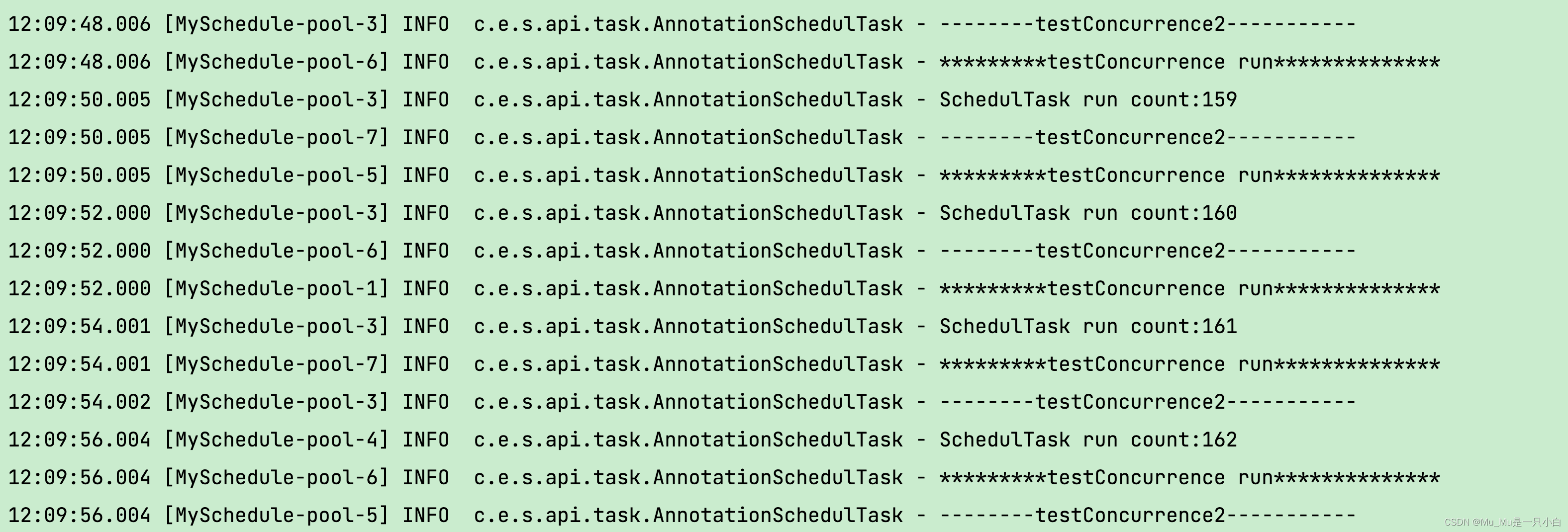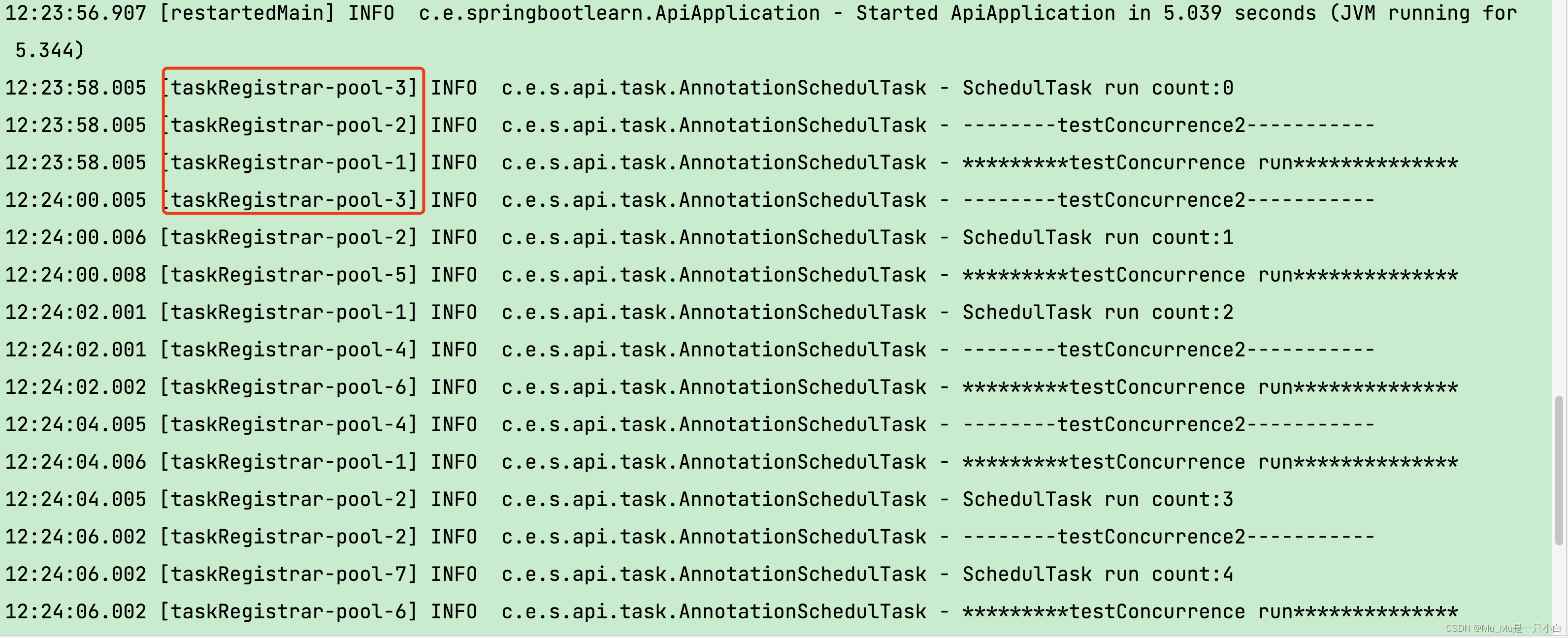1.在springboot启动器开启定时任务注解

这里的 @EnableScheduling 注解,它的作用是发现注解 @Scheduled的任务并由后台执行。没有它的话将无法执行定时任务。
2.使用的@Scheduled 注解
2.1 @Scheduled 的常用配置项
@Scheduled(fixedRate=2000):上一次开始执行时间点后2秒再次执行,无论上一个任务是否执行完过2s就开始下一个任务;
@Scheduled(fixedDelay=2000):上一次执行完毕时间点后2秒再次执行,上一个任务执行完后过2s 才执行下个任务;
@Scheduled(initialDelay=1000, fixedDelay=2000):第一次延迟1秒执行,
然后在上一次执行完毕时间点后2秒再次执行;
@Scheduled(cron=“* * * * * ?”):按cron规则执行。
在线Cron表达式生成器:http://cron.qqe2.com/介绍
3 实战
3.1 @Scheduled 多线程并发执行
@Scheduled 默认是使用单线程执行所有任务的。
1)验证:
编写多个@Scheduled 任务且设置执行时间和时间间隔都相同。
@Component
public class AnnotationSchedulTask {
private static final Logger LOG = LoggerFactory.getLogger(AnnotationSchedulTask.class);
private int count=0;
@Scheduled(cron = "0/2 * * * * ? ")
public void test(){
//0/1 第一次运行间隔0s,每次间隔1s运行一次
LOG.info("SchedulTask run count:"+count++);
}
/**
* 测试@Scheduled 默认是否是单线程运行
*/
@Scheduled(cron = "0/2 * * * * ? ")
public void testConcurrence(){
LOG.info("*********testConcurrence run**************");
}
/**
* 测试@Scheduled 默认是否是单线程运行
*/
@Scheduled(cron = "0/2 * * * * ? ")
public void testConcurrence2(){
LOG.info("--------testConcurrence2-----------");
}
}
启动服务运行结果:
可以看到所有任务都被 scheduling-1 线程执行

原因:
从ScheduledAnnotationBeanPostProcessor类开始一路找下去,在ScheduledTaskRegistrar(定时任务注册类)中的ScheduleTasks中又这样一段判断:
if (this.taskScheduler == null) {
this.localExecutor = Executors.newSingleThreadScheduledExecutor();
this.taskScheduler = new ConcurrentTaskScheduler(this.localExecutor);
}
当this.taskScheduler 为null 时
Executors.newSingleThreadScheduledExecutor(); 单个线程的线程池。
2)扩展多线程
其实只要设置一个我们自定义的this.taskScheduler
方法一:
配置一个ScheduledExecutorService bean即可设置
/**
* 执行周期性或定时任务
*/
@Bean(name = "scheduledExecutorService")
protected ScheduledExecutorService scheduledExecutorService()
{
return new ScheduledThreadPoolExecutor(corePoolSize,
new BasicThreadFactory.Builder().namingPattern("MySchedule-pool-%d").daemon(true).build(),
new ThreadPoolExecutor.CallerRunsPolicy())
{
@Override
protected void afterExecute(Runnable r, Throwable t)
{
super.afterExecute(r, t);
if (t == null && r instanceof Future<?>)
{
try
{
Future<?> future = (Future<?>) r;
if (future.isDone())
{
future.get();
}
}
catch (CancellationException ce)
{
t = ce;
}
catch (ExecutionException ee)
{
t = ee.getCause();
}
catch (InterruptedException ie)
{
Thread.currentThread().interrupt();
}
}
if (t != null)
{
log.error(t.getMessage(), t);
}
}
};
}
执行结果:
可以看到现在@Scheduled 由不同线程执行。

原理:
ScheduledAnnotationBeanPostProcessor 类的finishRegistration方法
最终在 this.registrar.setScheduler(resolveSchedulerBean(this.beanFactory, ScheduledExecutorService.class, false));
这一行 我们自定义的ScheduledExecutorService bean被当作执行的线程池。
方法2:
@Configuration
public class ScheduleConfig implements SchedulingConfigurer {
@Override
public void configureTasks(ScheduledTaskRegistrar taskRegistrar) {
taskRegistrar.setScheduler( new ScheduledThreadPoolExecutor(8,
new BasicThreadFactory.Builder().namingPattern("taskRegistrar-pool-%d").daemon(true).build(),
new ThreadPoolExecutor.CallerRunsPolicy()));
}
}
运行结果:
可以看出来也成功了,并且覆盖了我们之前设置的ScheduledExecutorService。

3.2 cron 表达式实现指定时间执行任务
1)cron 表达式详细介绍:
域 必填 允许值 允许的通配符
秒(seconds) 是 0-59整数 , - * /
分(minutes) 是 0-59整数 , - * /
时(hours) 是 0-23整数 , - * /
日(daysOfMonth) 是 1-31整数(需要考虑月的天数) , - * ? / L W
月(months) 是 1-12整数 或 JAN-DEC , - * /
周 (daysOfWeek) 是 1-7整数 或 SUN-SAT , - * ? / L #
通配符说明:
*:表示匹配该域的任意值。在minutes域使用 * 表示每分钟。在months里表示每个月。在daysOfWeek域表示一周的每一天。
?:只能用在daysofMonth和daysofWeek两个域,表示不指定值,当两个子表达式其中之一被指定了值以后,为了避免冲突,需要将另一个子表达式的值设为 ?。因为daysofMonth和daysofWeek会相互影响。例如想在每月的2号触发调度,不管2号是周几,则只能使用如下写法:0 0 0 2 * ?, 其中最后一位只能用?,而不能使用*,如果使用*表示不管周几都会触发。
-:表示范围。例如在minutes域使用5-20,表示从5分到20分钟每分钟触发一次
/:表示起始时间开始触发,然后每隔固定时间触发一次。例如在minutes域使用5/20,则意味着从当前小时的第5分钟开每20分钟触发一次。
,:表示列出枚举值。例如:在minutes域使用5,20,则意味着在5分和20分时各触发一次。
L:表示最后,是单词“last”的缩写,只能出现在daysofWeek和dayofMonth域。在daysofWeek域使用5L意思是在指定月的最后的一个星期四触发。在dayofMonth域使用5L或者FRIL意思是在指定月的倒数第5天触发。在使用L参数时,不要指定列表或范围。
W:表示有效工作日(周一到周五),只能出现在daysofMonth域,系统将在离指定日期的最近的有效工作日触发事件。例如:在daysofMonth使用5W,如果5号是周六,则将在最近的工作日周五,即4号触发。如果5号是周日,则在6日(周一)触发。如果5日在星期一到星期五中的一天,则就在5日触发。另外,W的最近寻找不会跨过月份 。
LW:这两个字符可以连用,表示指定月的最后一个工作日。
#:用于确定每个月第几个周几,只能出现在daysOfWeek域。例如在4#2,表示某月的第二个周三。
常用表达式示例:
0/2 * * * * ? 表示每2秒 执行任务
0 0/2 * * * ? 表示每2分钟 执行任务
0 0 2 1 * ? 表示在每月的1日的凌晨2点调整任务
0 15 10 ? * MON-FRI 表示周一到周五每天上午10:15执行作业
0 0 10,14,16 * * ? 每天上午10点,下午2点,4点
0 0/30 9-17 * * ? 朝九晚五工作时间内每半小时
0 0 12 ? * WED 表示每个星期三中午12点
0 0 12 * * ? 每天中午12点触发
0 15 10 ? * * 每天上午10:15触发
0 15 10 * * ? 每天上午10:15触发
0 15 10 * * ? 每天上午10:15触发
0 * 14 * * ? 在每天下午2点到下午2:59期间的每1分钟触发
0 0/5 14 * * ? 在每天下午2点到下午2:55期间的每5分钟触发
0 0/5 14,18 * * ? 在每天下午2点到2:55期间和下午6点到6:55期间的每5分钟触发
0 0-5 14 * * ? 在每天下午2点到下午2:05期间的每1分钟触发
0 10,44 14 ? 3 WED 每年三月的星期三的下午2:10和2:44触发
0 15 10 ? * MON-WED,SAT 周一至周三和周六的上午10:15触发
0 15 10 15 * ? 每月15日上午10:15触发
0 15 10 L * ? 每月最后一日的上午10:15触发
0 15 10 ? * 6L 每月的最后一个星期五上午10:15触发
0 15 10 ? * 6#3 每月的第三个星期五上午10:15触发
2)设置每天固定时间执行
//测试每天下午两点执行
@Scheduled(cron = "0 0 14 * * ? ")
public void testCron2(){
LOG.info("*********testCron2 run**************");
}
结果:
在下午两点被执行
14:00:00.005 [taskRegistrar-pool-1] INFO c.e.s.api.task.AnnotationSchedulTask - *********testCron2 run**************```
**3)设定没1分钟执行一次**
```java
//测试每分钟执行一次
@Scheduled(cron = "0 0/1 * * * ? ")
public void testFixedDelay(){
LOG.info("*********testFixedDelay run**************");
}
结果:
每分钟执行一次

4)设定每月几号执行一次
必须指定执行时间不然当天每分钟都会被执行一次。
//设定每月几号执行一次
@Scheduled(cron = "0 14 14 3 * ? ")
public void testFixedDay(){
LOG.info("*********testFixedDay run**************");
}
结果:
在 3号的 14.14 被执行。
